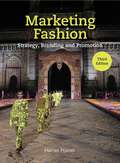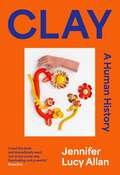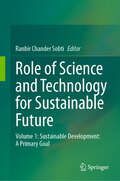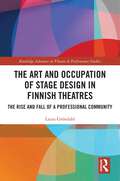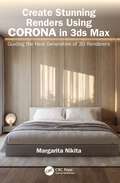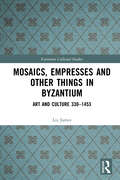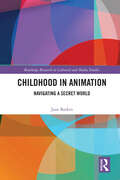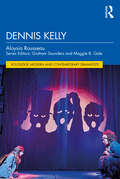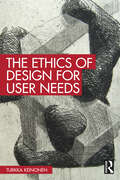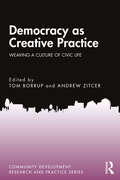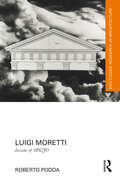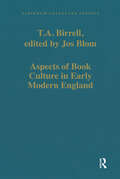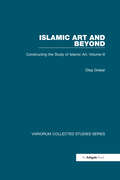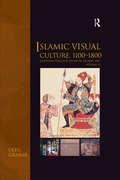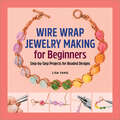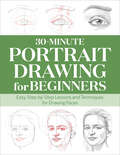- Table View
- List View
Marketing Fashion Third Edition: Strategy, Branding and Promotion
by Harriet PosnerMarketing Fashion is a practical guide to the fundamental principles of marketing, branding and promotion, from creating a customer profile to developing a brand identity. The book explains key concepts and illustrates how they are applied within the global fashion and retail industry, from haute couture to the mass market.For this third edition, examples drawn from a broad range of fashion, textile and retail have been updated to include more on social media and digital and emerging technologies, such as fashion in the metaverse. The updated text increases the focus on sustainability issues, while also tracing recent disruptions to traditional marketing frameworks such as degrowth. There are also more examples of global fashion weeks and brand collaborations. The book will appeal to students at degree or foundation level as well as those contemplating a career in the fashion industry.Chapters:Marketing TheoryThe Fashion MarketResearch & PlanningUnderstanding the CustomerBrandingPromotion
Clay: A Human History
by Jennifer Lucy Allan'Clay contains infinite possibilities in its transmutations, evidenced on the shelves of our homes, our galleries and museums. Every time we make something with clay, we engage with the timelines that are in the material itself, whether it was dug from a clifftop, riverbed or pit. In firing what we make, we bestow the material with function, meaning, or feeling, and anchor its form in a human present... Objects made from clay contain marks of our existence that collectively tell the story of human history more completely than any other material. There is a reason there are so many pots in museums: because fired clay is one of the most effective keepers of stories we have.'This book is a love letter to clay, the material that is at the beginning, middle and end of all of our lives; that contains within it the eternal, the elemental, and the everyday.People have been taking handfuls of earth and forming them into their own image since human history began. Human forms are found everywhere there was a ceramic tradition, and there is a ceramic tradition everywhere there was human activity. The clay these figures are made from was formed in deep geological time. It is the material that God, cast as the potter, uses to form Adam in Genesis. Tomb paintings in Egypt show the god Khnum at a potter's wheel, throwing a human. Humans first recorded our own history on clay tablets, the shape of the characters influenced by the clay itself. The first love poem was inscribed in a clay tablet, from a Sumerian bride to her king more than 4000 years ago. Born out of a desire to know and understand the mysteries of this material, the spiritual and practical applications of clay in both its micro and macro histories, Clay: A Human History is a book of wonder and insight, a hybrid of archaeology, history and lived experience as an amateur potter.
Role of Science and Technology for Sustainable Future: Volume 1: Sustainable Development: A Primary Goal
by Ranbir Chander SobtiThe book explores the pivotal role of science and technology in achieving the sustainable development goals (SDGs) outlined in the agenda 2030 for sustainable development. It emphasizes the importance of integrating science and technology into developing strategies to promote a sustainable and prosperous global future. The book highlights the universal acceptance of the SDGs by United Nations member states, subnational governing bodies, and international organizations. It emphasizes that all stakeholders, including governmental bodies, private enterprises, and civil society, have a responsibility to contribute to the achievement of the SDGs. Science, technology, and innovation are identified as the three pillars essential for achieving the SDGs. The book emphasizes the critical role of science and technology in addressing complex issues such as climate change, biodiversity loss, resource depletion, poverty reduction, health, education, gender equality, clean energy, sustainable cities, responsible consumption, and climate action. It helps to develop innovative solutions to promote economic growth, social inclusion, and environmental sustainability. And provide the necessary knowledge and tools to develop effective policies and strategies in these areas. Furthermore, the book highlights the potential of science and technology in promoting innovation and entrepreneurship, leading to the creation of new businesses and industries that align with sustainable development principles. This fosters economic growth, job creation, and environmental sustainability. It advocates for continued investment in science and technology and their integration into development strategies. The book aims to provide insights into the role of traditional and emerging areas of science and technology in meeting the goals outlined in the SDG document, with a specific focus on India. The book serves as a great source of information for researchers, teachers in basic and applied sciences /social sciences research and policymakers.
The Art and Occupation of Stage Design in Finnish Theatres: The Rise and Fall of a Professional Community (ISSN)
by Laura GröndahlThis study explores the formation, establishment, expansion, and disintegration of stage design as a modern profession and a recognized artform in Finnish theatres.Drawing on oral or written recollections and thoughts of stage designers from different decades, the author asks how their artistic agencies, occupational identities, and theoretical self-understanding have been constituted. She analyses Finnish theatre history from new perspectives by shifting the focus from finished performances to largely unknown practices behind the scenes. This book examines the cultural institutions that have constituted the stage designers’ role and position, like the professional city theatre system, the craft union, and education. This research shows how modern and postmodern scenographic innovations have been assimilated to local contexts, and how material and cultural circumstances have reshaped the artistic practices. Without bypassing canonical trendsetters or hegemonic cultural mindsets, the focus is directed on the everyday grassroot level of stage design practices. Personal interviews with over 20 designers make visible an ample repertoire of unwritten knowledge stored in habitual ways of working and dealing creatively with the complex system of theatre making.This book will be of great interest to students and scholars in theatre and performance studies with a focus on scenography.
Create Stunning Renders Using Corona in 3ds Max: Guiding the Next Generation of 3D Renderers
by Margarita NikitaThis book is a comprehensive step‑by‑step guide tailored for designers seeking to elevate their visualization skills using the powerful combination of Corona 11 in 3ds Max 2024.It begins by acquainting readers with the 3ds Max interface and fundamental commands, ensuring a solid foundation for navigating the software. Readers will be guided through the process of assigning Corona and fine‑tuning rendering settings, setting up cameras, and mastering both natural and artificial lighting techniques within their scenes.It then progresses to the creation of materials, their application to the scene, and the utilization of Corona’s libraries and presets for efficiency. The potentials of Corona are detailed using a bedroom scene as an example. This practical guide demystifies the complexities of 3D rendering without delving into modeling techniques.With design studios increasingly incorporating 3D renderings into their proposals, Create Stunning Renders Using Corona in 3ds Max: Guiding the Next Generation of 3D Renderers serves as an invaluable resource for professionals and aspiring renderers alike. It aspires to contribute significantly to the evolution of the next generation of 3D rendering artists, making it an essential companion for those eager to master the art of photorealistic renderings in the dynamic landscape of 3ds Max and Corona 11.
Mosaics, Empresses and Other Things in Byzantium: Art and Culture 330 – 1453 (Variorum Collected Studies)
by Liz JamesThis volume consists of 15 articles published between 1991 and 2018. It falls into three sections, reflecting different areas of Liz James’s interests.The first section deals with light and colour and mosaics: four articles considering light and colour in mosaics and the making of mosaics, as well as the question of what it means to define mosaics as ‘Byzantine’ are reprinted. The second brings together four pieces on empresses: their relationships with female personifications and the Mother of God; their roles in founding and refounding buildings; and their employment as ciphers by some authors. Finally, seven papers cover a range of topics: what monumental images of saints in churches might have been for; what the differences between relics and icons might have been; how captions to images can be misleading; why touch was an important sense; how words can sometimes ‘just’ be decorative rather than for reading; why the materiality of objects makes a difference. There is also a brief section of additional notes and comments which add to, update and reflect on each piece now in 2024.Mosaics, Empresses and Other Things in Byzantium will be of interest to scholars and students alike interested in material culture, the depiction of regal women, and the use of relics and icons in the Byzantine Empire.
Childhood in Animation: Navigating a Secret World (Routledge Research in Cultural and Media Studies)
by Jane BatkinChildhood in Animation: Navigating a Secret World explores how children are viewed in animated cinema and television and examines the screen spaces that they occupy.The image of the child is often a site of conflict, one that has been captured, preserved, and recollected on screen; but what do these representations tell us about the animated child and how do they compare to their real counterparts? Is childhood simply a metaphor for innocence, or something far more complex that encompasses agency, performance, and othering? Childhood in Animation focuses on key screen characters, such as DJ, Norman, Lilo, the Lost Boys, Marji, Parvana, Bluey, Kirikou, Robyn, Mebh, Cartman and Bart, amongst others, to see how they are represented within worlds of fantasy, separation, horror, politics, and satire, as well as viewing childhood itself through a philosophical, sociological, and global lens. Ultimately, this book navigates the rabbit hole of the ‘elsewhere’ to reveal the secret space of childhood, where anything (and everything) is possible.This volume will be of great interest to scholars and students of animation, childhood studies, film and television studies, and psychology and sociology.
Dennis Kelly (Routledge Modern and Contemporary Dramatists)
by Aloysia RousseauDennis Kelly explores Kelly’s unusual career path and sheds light on his eclectic approach to the arts, characterised by a refusal to write texts that people can fit within neat categories. This is the first monograph on Kelly’s work for stage and screen and brings to light his essential contribution to contemporary British drama and his huge range of work including his rise to international fame with Matilda the Musical.Drawing on Kelly’s published and unpublished texts, his work in production, reviews, original interviews with directors, actors and with Kelly himself as well as critical theory, Dennis Kelly examines and reappraises key motifs in his work such as his preoccupation with violence, the complex relationship between the individual and the community or his emphasis on storytelling. It also offers new insights into overlooked aspects of Kelly’s work by setting out to explore his traumatic narratives and his post-romanticism. In keeping with Kelly’s wish never to repeat himself, this study offers multiple critical entries into his plays, television series and films, drawing on moral and political philosophy, trauma studies, studies in humour, feminist theory and film studies.Part of the Routledge Modern and Contemporary Dramatist series, Dennis Kelly is addressed to students and scholars in Drama, Theatre and Performance as well as theatre practitioners and offers in-depth analysis of one of the most unique and challenging voices in contemporary British playwriting and screenwriting.
The Ethics of Design for User Needs
by Turkka KeinonenThis book offers an inquiry into the ethics of ‘human needs capture’ for design purposes by drawing upon ethical theories and narratives. Designers have historically relied upon the satisfaction of human needs as a moral justification for their profession. This volume offers an alternative critique to challenge this perspective, arguing that seeking to satisfy needs doesn't offer sufficient moral justification on its own. It presents an extensive ethical analysis of the notion of need and develops a thought-provoking case for a plural reconceptualisation of the notion of ‘need’ as user-based knowledge about product and service improvement opportunities. It does this by drawing upon a range of ethical approaches including Soran Reader’s needs ethics, classical utilitarianism, Robert Nozick’s libertarian philosophy, and John Rawls’ theory of justice. The book goes on to link these approaches to concepts guiding design such as human-centred design, collaborative design, and end user innovation. Written as a dialogue between a designer and his consciousness, the book underlines the deliberative nature of applied design ethics, and also highlights how consciousness challenges designers to solve their moral dilemmas. This engaging format invites readers to become an intimate part of the ‘discussion’. This book will be of interest to students and academics studying product design, industrial design, interaction design, user experience design, design ethics, and sustainable development.
Democracy as Creative Practice: Weaving a Culture of Civic Life (ISSN)
by Tom Borrup Andrew ZitcerDemocracy as Creative Practice: Weaving a Culture of Civic Life offers arts-based solutions to the threats to democracies around the world, practices that can foster more just and equitable societies. Chapter authors are artists, activists, curators, and teachers applying creative and cultural practices in deliberate efforts to build democratic ways of working and interacting in their communities in a range of countries including the United States, Australia, Portugal, Nepal, the United Kingdom, and Canada. The book demonstrates how creativity is integrated in place-based actions, aesthetic strategies, learning environments, and civic processes. As long-time champions and observers of community-based creative and cultural practices, editors Tom Borrup and Andrew Zitcer elucidate work that not only responds to sociopolitical conditions but advances practice. They call on artists, funders, cultural organizations, community groups, educational institutions, government, and others to engage in and support this work that fosters a culture of democracy.This book is intended for undergraduate and graduate students in the humanities and social sciences, activists, funders, and artists who seek to understand and effect change on local and global scales to preserve, extend, and improve practices of democracy.
Luigi Moretti: Lessons of SPAZIO (Routledge Research in Architecture)
by Roberto PoddaLuigi Moretti: Lessons of SPAZIO focuses on the theoretical work of the Italian architect Luigi Moretti (Rome, 1906–1973). It does so selectively, focusing on the editorials he published between 1950 and 1953 as editor-in-chief of the magazine SPAZIO, as well as a further essay on parametric architecture, published in 1971–1972, in the first issue of the magazine MOEBIUS, directed by his friend Giulio Roisecco.This book rediscovers Moretti's personal impact on international architectural theory through thoughtful comments that shed light on the architect's modernity and original approach. Although Moretti is an architect renowned for his projects and buildings, his theoretical essays are less well-known. The aim of this book is therefore to explore Moretti's theoretical work, which covers many topics, including pictorial art, sculpture, architecture, urban planning, music, cinema, poetry, mathematics, computer science, parametricity. In addition to the translation from Italian to English, the book contains reproductions of the original articles, accompanied by a series of essays of critical commentary and updated interpretations that show new ways of approaching, reading, and understanding the foundations of current architectural theory and its progress over the last 50 years. This book approaches Moretti's thought from a new perspective, with the aim of reconsidering the originality of this brilliant and visionary architect who was intellectually ostracised for many years due to political and ideological contingencies, even though he personified the ideal of the 'Renaissance man' in modern times.A re-reading of Moretti's work is more justified today than has ever been before, both to reconnect the threads with contemporaneity and to make his intensity and farsightedness of vision known to researchers, teachers, and students working in the areas of architecture and design theory, technology, and art today.
Aspects of Book Culture in Early Modern England (Variorum Collected Studies)
by T.A. Birrell edited by BlomThomas Anthony Birrell (1924-2011) was a man of many parts. For most of his working life he was Professor of English Literature in the University of Nijmegen, The Netherlands, where he was famous for his lively, humoristic and thought-provoking lectures. He was the author of some very popular literary surveys in Dutch, one of which - a history of English literature - has had seven editions so far. However, first and foremost he was a bibliographer and a book historian. The present collection contains fifteen of his book-historical articles, two reviews and one published version of a lecture for the illustrious ’Association Internationale de Bibliophilie’. The lecture - with a wealth of illustrations - about the British Library as the ’Custodian of the Unique’ gives one a sense of Birrell’s ability to present an audience with a complicated topic in comprehensible, but not simplified, terms. The reviews serve as a statement of principle of how to tackle the subject of ’English readers and books’ and the standards that ought to apply. The articles demonstrate Tom Birrell’s in-depth knowledge, dedication and scholarship. He once said that he felt that he could have talked to the 17th-century London booksellers on an equal footing and his work convinces one that they would have enjoyed these conversations. Aspects of Book Culture was edited by Birrell’s former pupil, colleague, friend and fellow-bibliographer Jos Blom.
Islamic Art and Beyond: Constructing the Study of Islamic Art, Volume III (Variorum Collected Studies)
by Oleg GrabarIslamic Art and Beyond is the third in a set of four volumes of studies on Islamic art by Oleg Grabar. Between them they bring together more than eighty articles, studies and essays, work spanning half a century by a master of the field. Each volume takes a particular section of the topic, the three other volumes being entitled: Early Islamic Art, 650-1100; Islamic Visual Culture, 1100-1800; and Jerusalem. Reflecting the many incidents of a long academic life, they illustrate one scholar's attempt at making order and sense of 1400 years of artistic growth. They deal with architecture, painting, objects, iconography, theories of art, aesthetics and ornament, and they seek to integrate our knowledge of Islamic art with Islamic culture and history as well as with the global concerns of the History of Art. In addition to the articles selected, each volume contains an introduction which describes, often in highly personal ways, the context in which Grabar's scholarship developed and the people who directed and mentored his efforts. The articles in the present volume illustrate how the author's study of Islamic art led him in two directions for a further understanding of the arts. One is how to define Islamic art and what impulses provided it with its own peculiar forms and dynamics of growth. Was it a faith or a combination of social, historical, and cultural events? And how has 'Islamic art' impacted on the contemporary arts of the Islamic world? The other issue is that of the meanings to be given to forms like domes, so characteristic of Islamic art, or to terms like symbol, signs, or aesthetic values in the arts, especially when one considers the contemporary world. The Islamic examples allow for the development of new intellectual positions for the history and criticism of the arts everywhere.
Islamic Visual Culture, 1100-1800: Constructing the Study of Islamic Art, Volume II (Variorum Collected Studies)
by Oleg GrabarIslamic Visual Culture, 1100-1800 is the second in a set of four volumes of studies on Islamic art by Oleg Grabar. Between them they bring together more than eighty articles, studies and essays, work spanning half a century by a master of the field. Each volume takes a particular section of the topic, the three other volumes being entitled: Early Islamic Art 650-1100; Islamic Art and Beyond; and Jerusalem. Reflecting the many incidents of a long academic life, they illustrate one scholar's attempt at making order and sense of 1400 years of artistic growth. They deal with architecture, painting, objects, iconography, theories of art, aesthetics and ornament, and they seek to integrate our knowledge of Islamic art with Islamic culture and history as well as with the global concerns of the History of Art. In addition to the articles selected, each volume contains an introduction which describes, often in highly personal ways, the context in which Grabar's scholarship developed and the people who directed and mentored his efforts. The focus of the present volume is on the key centuries - the eleventh through fourteenth - during which the main directions of traditional Islamic art were created and developed and for which classical approaches of the History of Art were adopted. Manuscript illustrations and the arts of objects dominate the selection of articles, but there are also forays into later times like Mughal India and into definitions of area and period styles, as with the Mamluks in Egypt and the Ottomans, or into parallels between Islamic and Christian medieval arts.
The Camp Dutch Oven Cookbook: Easy 5-Ingredient Recipes to Eat Well in the Great Outdoors
by Robin DonovanSimple, flavorful 5-ingredient Dutch oven meals to savor under the stars Cooking at your campsite doesn't have to mean canned beans and instant noodles. Redefine camp cuisine with a camping-style Dutch oven, a few easy ingredients, and The Camp Dutch Oven Cookbook. This compact cookbook is packed with more than 85 unique 5-ingredient recipes, making it the ideal outdoor companion for surprisingly simple gourmet meals. Whether you're a new or seasoned camper, you'll learn everything you need to know to make fresh, flavorful dishes at your campsite, from food-packing hacks to easy cooking techniques. The recipes only require five or fewer wholesome ingredients (not including staples like salt, pepper, butter, and oil)—nothing processed or hard-to-find. With this one pot cookbook and your Dutch oven, you'll discover how satisfying campsite-cooked meals can be. The Camp Dutch Oven Cookbook features: 86 Hearty 5-ingredient recipes—Dig in to Lemon Buttermilk Biscuits, Green Chile and Corn Chowder, Chicken Braised in Coconut Milk with Basil, Crusty No-Knead French Bread, and much more. Dutch oven guidance—Mastering outdoor cooking is a breeze with guides for purchasing, seasoning, cleaning, and cooking with your camp-style Dutch oven. Outdoor cooking hacks—Discover tips and tricks for creating a "cooking kit," meal planning, pre-prepping ingredients, and staying safe while cooking. Savor great meals in the great outdoors with The Camp Dutch Oven Cookbook.
Photography for Kids: A Beginner's Book
by JP PullosBecome a photographer with this guide to photography for kids ages 8 to 12 A good photo can tell a story, express your creativity, and document moments from your life in a way that only you can capture. Learn how to create incredible images that are uniquely yours with this guide to photography for kids. All you need is the most basic digital camera or smartphone camera—no fancy equipment required. You'll learn all about framing, composition, lighting, depth, dimension, and lines. Then, put your new knowledge into practice with engaging exercises that include step-by-step instructions. This book about photography for kids includes: Photography fundamentals—Discover how a camera works, a brief history of photography, what makes a photo good, and a checklist for getting started. Example photos—Explore high-quality photographs that illustrate the concepts you're learning and inspire you to get creative. Tips and how-tos—Find pointers that explain the technical details of great photos and show you ways to make adjustments in a variety of real-life situations. Discover the joy of photography with this beginner-friendly book about photography for kids.
Stomp, Wiggle, Clap, and Tap: My First Book of Dance
by Rachelle BurkGet toddlers ready for preschool with this delightful dance book for children ages 1-3Toddlers are natural dancers, and they love to move! Release some of that endless toddler energy and help them develop balance and coordination with Stomp, Wiggle, Clap, and Tap. Moving along with the story will help stimulate little brains and provide a fun, creative way to build spatial awareness. Tons of colorful pictures offer toddlers visual clues for the movements, and the rhyming words make reading aloud feel like music.Movement and motor skills—Little ones will begin by learning to isolate individual body parts, like their hands, hips, arms, and toes, then move their whole body.Dynamic dancing—Toddlers will harness their imagination when they dance with silly moves like Prancing Pony, Flapping Chicken, and Twirling Pinwheel.Keep the fun going—Explore a list of online dance videos and resources to help them keep moving and developing even when the book is finished.Set the stage for an active childhood with this standout in books for toddlers.
The Beginner Art Book for Kids: Learn How to Draw, Paint, Sculpt, and More!
by Daniel Freeman Korri FreemanPainter, printmaker, sculptor—show kids 7 to 10 that they can be any kind of artist! Come along on an artistic adventure with The Beginner Art Book for Kids. This creative compendium is the latest and greatest in art books for kids, packed full of imaginative art projects and inspiration for budding artists aged 7 to 10—or for anyone who wants to get started making art. Unlike other art books for kids, this collection features a variety of real artistic techniques for you to try. Follow the step-by-step instructions or use the projects as a jumping-off point for new ideas. Every artist has the ability to create something special, including a beginner—including you! This standout among art books for kids includes: Start here—Whether you've never made art before or already love to create, these guided projects will help unlock your imagination. 46 creative ideas—Make all kinds of awesome art—from animal sculptures to modern portraits—using easy-to-find supplies and materials. Explore techniques—Try classic art methods you won't find in other art books for kids, like contour line drawing, mosaic, relief printing, splatter painting, and more. Start making art today with this authentic choice in art books for kids!
Crochet for Beginners: A Stitch Dictionary with Step-by-Step Illustrations and 10 Easy Projects
by Arica PresinalLearn how to crochet with this complete beginner's guideWith just a little yarn and a crochet hook, you can enjoy a relaxing new hobby while creating beautiful gifts, garments, and decor. This crochet book for beginners shows you how to get started with step-by-step instructions and illustrations for 30 fundamental crochet stitches and techniques—plus a collection of fun projects to help you practice your skills.What sets Crochet for Beginners apart from other crochet books:The basics of crochet—Learn the different types of hooks and yarn, essential and nice-to-have tools, and explanations of important crochet terms.Skill-building stitches—Start with the most basic stitches and work your way up to more intricate ones as you learn techniques like following a pattern, joining pieces, changing colors, and more.10 beginner projects—Put everything you learn into practice with easy crochet patterns for beginners, including a beanie, a crochet tool holder, a circle bag, and a blanket.Develop your crochet skills with this beginner-friendly guide to success.
Creative Paper Crafts: 35 Cool, Customizable Projects for Crafty Kids
by Lisa GloverTransform paper into unique keepsakes with hands-on crafts for kids 8-12 With a little cutting, folding, and gluing, kids can turn paper into cool gadgets, games, and accessories—like a Starry Night Globe, a Tiny Ticket Suitcase, a Fleecy Alpaca, and more. Creative Paper Crafts shows them how with 35 templates included right inside the book, so all they have to do is cut them out and get crafting! With detailed instructions and step-by-step photos, kids will create their own impressive paper treasures in no time. Tips and tricks—This book sets kids up for success with a quick introduction to preparing their workspace, choosing materials, and paper crafting terms like "scoring" and "quilling." No special tools required—Kids just need some basic household items like paper, scissors, glue, and pencils to complete these projects. For all skill levels—Kids can try out simple crafts like the Archipelago Bookmarks and the Uplifting Envelopes Card, or more difficult crafts like a Scaled-Down Crown and a Book Nook Alley. Help kids have a blast learning new skills with this book of awesome paper crafts.
The Story of Stan Lee: An Inspiring Biography for Young Readers (The Story of Biographies)
by Frank J. BerriosDiscover the life of Stan Lee—a story about creating your own adventures for kids ages 6 to 9Stan Lee was a famous comic book writer, artist, editor, and publisher for Marvel Comics. Before he helped create heroes like the Incredible Hulk, Spider-Man, the X-Men, and Black Panther, Stan was an imaginative boy who spent hours reading all sorts of different stories and letting his thoughts run wild. These stories inspired him to come up with exciting plots and new characters of his own.Independent reading—This Stan Lee biography is broken down into short chapters and simple language so kids 6 to 9 can read and learn on their own.Critical thinking—Kids will learn the Who, What, Where, When, Why, and How of Stan's life, find definitions of new words, discussion questions, and more.A lasting legacy— Explore how Stan went from being a young boy growing up in New York City to a comic book legend.How will Stan's colorful imagination and hard work inspire you?Discover activists, artists, athletes, and more from all across history with the rest of The Story Of series, including famous figures like: Albert Einstein, Amelia Earhart, Jim Henson, Fred Rogers, and Frida Kahlo.
Rock Painting For Beginners: Simple Step-by-Step Techniques
by Adrianne SurianLearn how easy it is to create colorful painted rocks with Rock Painting for Beginners If you've ever wanted to dabble in rock painting, this is the perfect book for you. This guide for beginners will teach you how to feel confident with a paintbrush with step-by-step art projects. Learn how to create beauty in your life with a craft that's easy to do. Learn how to use the tools and paints needed, and what kinds of rocks to seek out. From tape-resistant painting to hand lettering to stencils and stamps, start your journey in rock painting with art projects designed to refine specific techniques. Get inspired with ideas to engage with your community and spread joy with small painted rocks around your neighborhood, your city, and beyond. Cultivate your creativity with this fun, encouraging rock painting book for beginners.
Origami Made Simple: 40 Easy Models with Step-by-Step Instructions
by Russell WoodSpark a lifetime of creativity with a few sheets of paper! Discover the art of paper folding with Origami Made Simple. Featuring 40 classic and original origami models, complete with detailed diagrams and written instructions for every step, it's the fastest way for you to start creating eye-catching paper sculptures. If you're new to origami, the iconic yet approachable designs in this book are a great way to hone your skills—and have a blast doing it. Start with straightforward models that take 10 steps or less and work your way up to more complex creations. No matter the level of difficulty, every model is diagrammed for ease of use, with tricky folds highlighted and broken down into multiple steps. This origami book includes: Classic and contemporary—Try your hand at recognizable models, like Crane and Sailboat, as well as original designs, like Cobra and Teapot. Tips and techniques—Pay attention to tips that help you select the right paper, work through tough steps, and add your own creative twist. Symbol glossary—Find a comprehensive guide to standard origami symbols, as well as helpful info on how to read origami diagrams. Fold up some fun with Origami Made Simple!
Wire Wrap Jewelry Making for Beginners: Step-by-Step Projects for Beaded Designs
by Lisa YangCreate beautiful wire wrap jewelry with 20 beginner-friendly projects If you're interested in making your own jewelry, wire wrapping is a great technique to start with. The jewelry is easily joined and decorated by shaping, twisting, wrapping, coiling, and weaving wire. In this jewelry-making guide, you'll learn how to create 20 projects that will progressively build your skills. What you need to get started—Learn about the easy-to-use, budget-friendly tools that make wire wrapping perfect for beginners. Learn simple techniques—Set yourself up for success with illustrated, step-by-step directions for creating loops, adding beads, and more. Engaging, eye-catching projects—Make trendy pieces to enhance your wardrobe, including bracelets, rings, necklaces, and earrings. Create beautiful wire wrap jewelry that will dazzle your friends and family.
30-Minute Portrait Drawing for Beginners: Easy Step-by-Step Lessons and Techniques for Drawing Faces (30-Minute Drawing for Beginners)
by Rockridge PressLearn to draw portraits with easy 30-minute lessons Do you want to develop the skills to create detailed and expressive portraits? This book makes it easy! Each page guides you through short, at-home lessons on how to draw realistic faces. As you work your way through step-by-step instructions for everything from choosing supplies to outlining a face and sketching each feature, you'll start to transform basic lines into fully-formed portraits. No experience required—These exercises are designed for complete beginners, helping you learn the foundations of drawing in bite-size lessons. Quick and simple exercises—With activities that only take half an hour, it's easy to make time to draw on a coffee break, over lunch, or whenever your schedule allows. Grow your skills—Explore techniques that build on each other as you play with key elements like shadow, light, and texture. Spark your artistic side with 30-Minute Portrait Drawing for Beginners!
